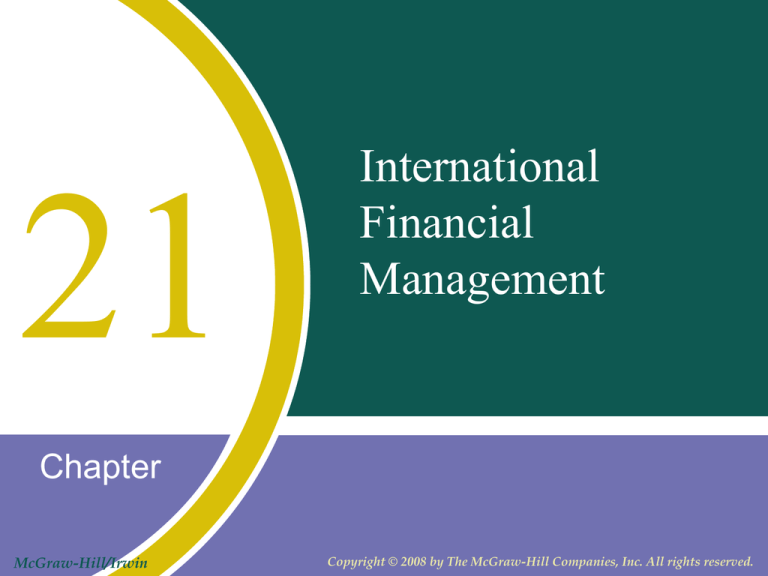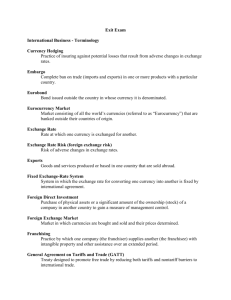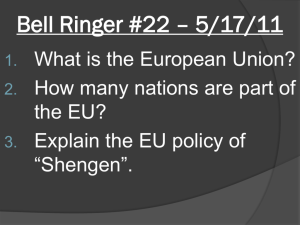
21
International
Financial
Management
Chapter
McGraw-Hill/Irwin
Copyright © 2008 by The McGraw-Hill Companies, Inc. All rights reserved.
Chapter Outline
• The multinational corporation.
• Effect of exchange rates.
• Hedging and reduction of foreign exchange
risk.
• Evaluating political risk in foreign
investments.
• Ways of financing international operations.
21-2
Introduction
• Integrated global economy and increased
interdependence.
• Trade Organizations and removal of trade
barriers: WTO, NAFTA.
• Enhanced prospects for international
understanding.
• Role of world politics in economic
development.
21-3
Growing Interdependency
• Integrated nature of capital markets
– Possible declines beyond the expected
economic impact of an event.
• Currency markets
– Impact trade between nations affecting sales
and earnings of international companies.
• The advent of Euro.
– Impact on earnings of U.S companies doing
significant business in Europe.
21-4
One Euro to the U.S. Dollar and the
British Pound
21-5
International Sales of Selected U.S.
Companies
21-6
The Multinational Corporation:
Nature and Environment
• A firm doing business across its national
borders.
• Can take on various forms.
– Exporter.
– Licensing Agreements.
– Joint Venture.
– Fully Owned Foreign Subsidiary.
21-7
The Multinational Corporation: Nature
and Environment (cont’d)
• Exporter
– Least risky method.
– Reap of benefits of foreign demand.
– No long-term investments commitment required.
• Licensing Agreements
– License granted to an independent, local
manufacturer.
– Returns include licensing fee or royalty.
– Effective exporting technology.
21-8
The Multinational Corporation: Nature
and Environment (cont’d)
• Joint Venture
– Established with a local foreign firm.
– Most conducive environment - legal, political
and economic.
• Fully owned foreign subsidiary
– Higher risks and complexities of operation.
– Lowers portfolio risk of the parent corporation.
– More profitable than domestic firms.
– Decisive factor in shaping the pattern of trade,
investment, and the flow of technology.
21-9
Factors Influencing Exchange Rates
• The currencies of major trading partners of
the United States are traded in free markets.
– Exchange rate is determined by the supply of,
and demand for, those currencies.
– This activity is subject to intervention by many
countries’ central banks.
21-10
Exchange Rates to the Dollar
21-11
Other Factors Influencing Exchange
Rates
• Inflation:
– Purchasing power parity theory:
• Exchange rates vary inversely with their respective
purchasing powers.
• Provides the same or similar purchasing power in
each country.
• Interest rates:
– Interest rate parity theory:
• The interplay between interest rates differentials and
exchange rates.
21-12
Other Factors Influencing Exchange
Rates (cont’d)
• Balance of payments:
– Government accounts that catalogue flow of
economic transactions between countries.
• Trade surplus and trade deficit.
• Government policies:
– Intervention in the foreign exchange market.
– Maintenance of undervalued currency.
– Currency values set by government decree.
– Restriction of the inflow and outflow of funds.
– Monetary and fiscal policies.
21-13
Other Factors Influencing Exchange
Rates (cont’d)
• Other factors:
– Extended stock market rally.
– Significant drop in demand for a nation’s
principal exports globally.
– Political turmoil in a country .
– Widespread labor strikes.
21-14
Spot Rates and Forward Rates
• Spot rate
– Exchange rate at which the currency is traded
for immediate delivery.
• Forward rates
– Trading of currencies for future delivery.
– Reflects the expectations regarding the future
value of a currency.
• Discount or premium:
– Expressed as an annualized percentage
deviation from the spot rate.
21-15
Cross Rates – Key Currency Cross
Rates as of February 21, 2006
21-16
Managing Foreign Exchange Risk
• Foreign exchange risk
– Possibility of a drop in revenue or an increase in
cost in an international transaction due to
changes in foreign exchange rates.
• Free trading - freely floating rate system.
– Increased volatility forced the attention towards
foreign exchange risk management.
• Exchange risk of a multinational company:
– Accounting or translation exposure
– Transaction exposure
21-17
Translation Exposure
• MNC’s foreign assets and liabilities are
exposed to losses and gains due to
changing exchange rates.
• The SFAS 52:
– Requires all foreign currency-denominated
assets and liabilities to be converted at the rate
of exchange.
– Partially reduces the impact of accounting
exposure.
21-18
Transaction Exposure
• Foreign exchange gains or losses resulting
from international transactions.
– Volatility of reported earnings per share
increases.
– Different strategies can be used to minimize
transaction exposure:
• Forward exchange market hedge.
• Money market hedge.
• Current futures market hedge.
21-19
Other Forms of Protection against
Foreign Exchange Risk
• MNC’s have developed foreign asset
management programs, involving strategies:
– Switching cash and other assets into strong
currencies.
– Piling up debt and other liabilities in depreciating
currencies.
– Quick collection of bills in weak currencies by
offering sizable discounts, while extending
liberal credit in strong currencies.
21-20
Foreign Investment Decisions
• Factors encouraging foreign affiliates:
– Avoid the imposition of trade barriers.
– Lower production costs overseas.
– American technology enabled exploitation of
resources in developing countries.
– Advantages related to taxes.
– Motivation of working in a oligopolistic industry.
– International diversification of risks.
21-21
Risk Reduction from International
Diversification
21-22
Foreign Investment Decisions
(cont’d)
• Deterrents:
– Government interference by imposition of
unfriendly foreign exchange restrictions.
– Limitation of foreign ownership to a small
percentage.
– Repatriation of a subsidiary’s profits to the
parent firm may be blocked temporarily.
– Government may expropriate the foreign
subsidiary’s assets.
21-23
Guarding Against Political Risk
• Investigate the countries political stability methods include:
– Establish a joint venture with a local
entrepreneur.
– Establish a joint venture with firms from other
countries.
– Insurance against perceived political-risk level
can be obtained.
• Overseas Private Investment Corporation (OPIC).
• Insurance or political-risk umbrella is not
cheap.
21-24
Financing International Business
Operations
• Credit sales are influenced by:
– Relationship of the parties involved.
– Political stability of countries involved.
• Risk of nonpayment induces importer’s
banks to issue letter of credit.
– Credit risk to exporter is absorbed by the
importer’s bank.
– Exporters requiring cash payment or a letter of
credit generally loses out on further orders.
21-25
Financing International Business
Operations (cont’d)
• Alternatives to avoiding loss of business:
– Obtaining export credit insurance.
• The Foreign Credit Insurance Association (FCIA)
provides this kind of insurance.
21-26
Funding of Transactions
• Eximbank (Export-Import Bank)
– Direct loan program.
– Discount program.
• Loans from the parent company.
– Parallel loans.
– Fronting loans.
• Eurodollar loan
– US dollars deposited in foreign banks.
– Lending rates based on London Interbank
Offered Rate (LIBOR).
21-27
Funding of Transactions (cont’d)
• Eurobond market
– Issues are sold in several national capital
markets.
– Widely used currency – U.S. dollar.
• International equity markets
– Companies are listed on major stock exchanges.
– Issue American Depository receipts (ADRs).
• The International Finance Corporation (IFC)
– Approached by companies facing issues with
raising equity capital in a foreign country.
21-28
Some Unsettled Issues in
International Finance
• Nature of financial decisions for an MNC are
complex:
– Access to more sources of funds than a purely
domestic corporation.
– Interest rates and market conditions may differ.
– Corporate financial factors may differ.
– Control over financial decisions is a factor.
– Dividend policy decisions may be influenced by
foreign government regulations.
21-29
Cash Flow Analysis of a Foreign
Investment
21-30






